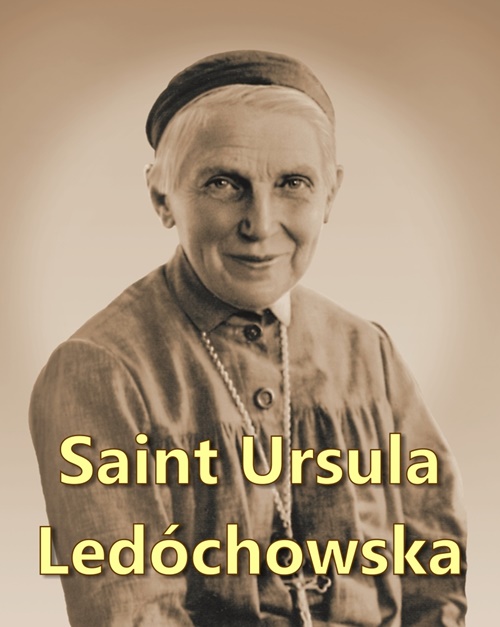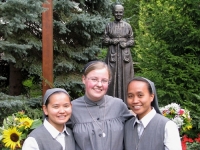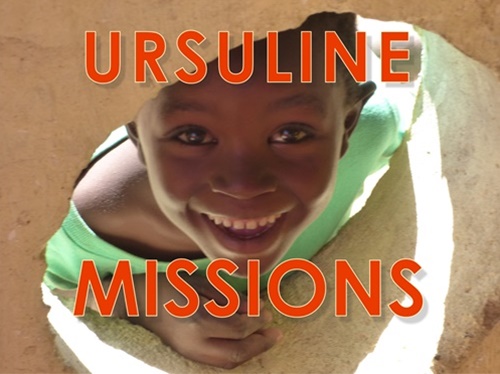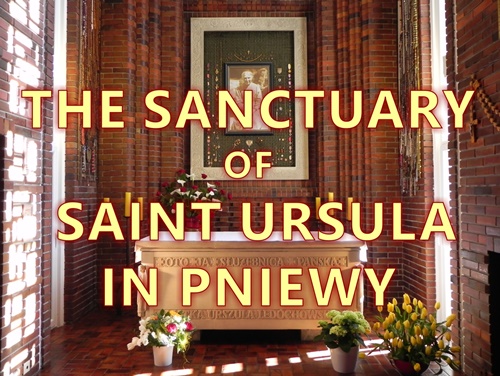
Ursuline sisters
Children categories
History

God himself planned everything, directed everything. (…) I was only a pawn on a chessboard that was being moved, controlled and sent from one place into another, from one country into another one by a higher hand till the realization of not mine plans – as I never planned it – but God’s plan. (Mother Ursula)
The Congregation of the Ursuline Sisters of the Agonizing Heart of Jesus, founded in 1920 by St. Ursula Ledóchowska, is one of the numerous branches of the Ursuline family, established in the 16th century by St. Angela Merici.
The community of the Ursulines in Petersburg, with mother Ursula as its superior, the period of World War I, after the exile from Russia, spends first in Sweden and later in Denmark. When Poland regains its independence, mother Ursula together with her community returns to Poland and settles in Pniewy near Poznań. The sisters take orphans of Polish immigrants with them. These are children that they took care of in Denmark. The Apostolic See transfers the legal status of the autonomous Ursuline house in Petersburg into Pniewy and transforms the community into the Congregation of the Ursuline Sisters of the Agonizing Heart of Jesus. On June 4, 1923, the Apostolic See for the first time approves the Constitutions of the Congregation that are later definitely approved on November 21, 1930.
The Congregation develops quickly. Mother Ursula with her sisters actively participates in the restoration of Poland in a way accessible to them. The number of sisters raises and that increases the number of the Order’s communities and works. Sisters organize kindergartens, schools, orphanages, boarding schools for youth from secondary schools, halls of residence; they run vocational trainings for girls, community halls and reading rooms for children and youth; they begin to catechise in state schools. They also take care of the formation of the future catechists and teachers. In 1921 sisters acquire an old and destroyed post-Dominican monastery in Sieradz. The monastery, restored with the help of sisters, soon becomes religious and cultural centre that has a strong influence on the locals. In 1922 sisters begin to catechise in a newly established diocese of Łódź, where they create a strong catechetical centre that educates secular catechists. In 1925 a hall of residence for girls is established in Vilnius and two years later sisters create a socio-economic school in Czarny Bór. In the next few years establishments in Volhynia and Polesie are created. Mother Ursula tries to enforce a desire once mentioned to her brother Włodzimierz: “I wish to encompass village and in threes: one folk teacher, one nurse and one housekeeper to be sent there in order to convert the village in threes”.
In 1928 the first community of Grey Ursulines is founded in Rome with a hall of residence for Polish and Italian youth next to it. Soon, the Congregation’s general house is established since mother Ursula has a strong wish to have a house in the shadow of the Holy Father. In 1932 sisters take up work among the poor on the outskirts of Rome. In 1930 they go to France with girls emigrating to work in silk factories. Mother Ursula also makes an effort to send sisters to Peru. However, her plans do not eventuate due to the lack of funding.
Mother Ursula also transfers the Eucharistic Movement to Poland, which by the end of her life encompasses almost 200.000 children. Two of the Congregation’s printing houses support education – mainly of children and youth – by good books (mother Ursula herself wrote a few children’s stories) and publications of a formation character (The Bell of St. Olaf, The Host, the Eucharistic Apostle).
At the time of death of the Foundress (1939) the Congregation consists of 800 sisters in 44 communities in Poland, Italy and France.
The second stage of the Congregation’s history begins, which seems to be an uneasy test of the Congregation’s spiritual and apostolic resiliency. The warfare and the policy of the occupational authorities force sisters to leave a number of their houses, mainly those on the territories annexed to the Reich and those grabbed by the Soviet Union. Sisters adapt to the changed living and working conditions in a very flexible way. Despite the imminent repressions (about 200 of them are evacuated, 107 are deported to the Nazi and Soviet camps and prisons, 5 are exiled to Siberia and 66 to forced labour camps in Nazi Germany) sisters take care of the sick and the prisoners of war (in Poland, mainly in Sieradz but also in Italy and France). Furthermore, they organise underground education for primary and secondary schools, orphanages and free kitchens for the needy. They involve in underground activities, in supporting the displaced, prisoners, refugees, persecuted, also Jews. Ursulines rescue the Jewish children by hiding them in their houses. Four sisters are killed while helping the injured during the Warsaw Uprising. Another two sisters after few years of wartime wandering through USSR, Persia and the Indian Ocean get to New Zealand (1944) with 736 Polish children.
In the postwar period, when the rebirth of Poland begins, sisters return to the old places and look for new scope of action, especially in the field of teaching, education and charity work. The policy of the Communist authorities forces them to a constant vigilance and flexibility. Uneasily rebuilt educational work is eventually taken by the state and sisters are expelled from schools. They are divested of the household school for girls in Pniewy and the hall of residence for 140 students in Warsaw. Moreover, the kindergartens, boarding houses, community halls and libraries are either abolished or nationalised. The orphanages go into the administration of “Caritas”. This situation forces sisters to take up new tasks: catechisation, other forms of work in parishes, various types of work for the community as well as work in Church institutions and at Catholic Universities (KUL, ATK) and the formation work with youth.
In 1965 sisters arrive in Canada, where they take up work in a Polish parish in Windsor (Ontario), teach in Canadian schools as well as in the Polish school and open their own kindergarten. Currently, they also work in London and Ottawa. In 1969 a group of Grey Ursulines goes to Argentina and in 1971 to Brazil. In 1976 the Congregation begins to work in Finland and in 1980 in the houses for youth, which belong to an international organization In Via in Munich (Germany). In 1988 sisters undertake apostolic work in Ukraine and in 1995 in Belarus. The missionary work in Africa begins in 1990 in Tanzania and from 2002 sisters are on the Philippines in Asia. In 2008, 100 years after mother Ursula’s departure from Russia, the Ursulines resume their work in Petersburg in St. Catherine’s Parish. In 2009 Bolivia joins the “grey missions” in South America.
About us
Founded by St. Ursula Ledóchowska, and also known as the Grey Ursulines, the Congregation is one of the numerous branches of the Ursuline family brought into being in 16th century by St. Angela Merici.
The special mission of the Congregation is to proclaim Christ – the love of His Heart – by educating and teaching children and young people, by serving the needy and those suffering from discrimination and through other activities which seek to evangelise the world.
The Congregation seeks to fulfill its mission under the direction and motherly protection of Our Lady, venerated as the Star of the Sea. The words of Mary: Behold, I am the handmaid of the Lord. May it be done to me according to your word – are the motto of our Congregation. (The Constitution of the Congregation)
Teaching and educating as well as helping the poor are the main apostolic activities in all the countries in which we live.
At present, the Congregation consists of about 800 sisters in almost 100 communities in 14 countries on 5 continents.
According to the needs of the country we serve as catechists and teachers, as teachers in orphanages, kindergartens, boarding schools, students' hostels and day rooms, as developers of young people (groups and communities, retreats and spiritual accompaniment), among emigrants as well as on missions in Latin America and Africa.











